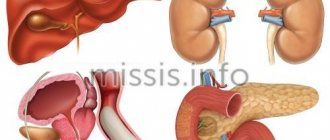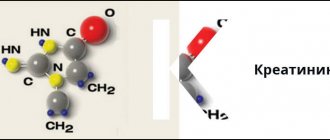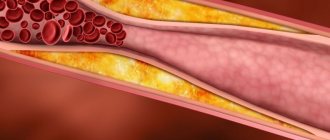Potassium and its significance in a biochemical blood test (K)
Potassium (“K”) is an essential chemical element that creates the necessary conditions for various reactions to occur. It is found in the body in the form of cations - positively charged ions located inside the cell (in the intracellular fluid).
The content in the intercellular fluid is no more than 2% - this is exactly the potassium that is determined during biochemical analysis. A change in this indicator can be observed both in various physiological conditions and in pathology, and a decrease in the concentration in the blood - hypokalemia - is life-threatening and can have serious consequences.
The norm is 3.4 – 5.0 mmol/l. At the same time, it provides:
- Correct heart rate;
- Myocardial contraction;
- The work of skeletal muscles;
- Conduction of nerve impulses through neurons;
- Water-salt balance.
For normal maintenance of the above functions, a sufficient supply of “K” from food is necessary, since there are no own reserves of this chemical element. A lot is found in vegetables (especially greens, potatoes), fruits and grains.
The level of “K” is affected by the rate of its elimination. A decrease in concentration is caused by:
- Kidney diseases;
- Water-salt and acid-base imbalance;
- Hormonal changes (especially mineralocorticoids);
- Uncontrolled use of diuretics;
- Intoxication with repeated vomiting or diarrhea;
- Severe inflammatory processes;
- Deficiency of other minerals;
- Disorders of respiratory and circulatory function.
Hypokalemia – level in biochemistry less than 3.5 mmol/l. At the same time, it develops:
- Severe fatigue;
- Muscle pain;
- Arrhythmia up to cardiac arrest;
- Reduced activity of gastrointestinal motility with subsequent constipation up to dynamic intestinal obstruction;
- Slowing reflexes;
- Slowing down of mental processes;
- Pathology of urination.
Conditions in which the norm is exceeded - hyperkalemia - are somewhat less common. However, this happens when:
- Kidney failure;
- Reverse mineralocorticoid disorders;
- Release of the cation into the intercellular space due to extensive injuries, tumors, poisoning, taking antibiotics or chemotherapy drugs, acid-base imbalance;
- Overdose of drugs with “K”;
- Enhanced diet.
The clinical picture of hyperkalemia is similar to the symptoms that occur with ion deficiency. This is due to the general nature of the occurrence of such signs - a violation of the electrochemical potential of membranes, which is characterized by:
- Arrhythmia;
- Weakening of skeletal muscles up to paralysis;
- Apathetic mood;
- Blood pressure instability (jumps from low to high).
Thus, the exchange of “K” is extremely important for maintaining the normal functioning of both each individual cell and the entire organism as a whole. Therefore, if any symptoms appear that may correspond to hypo- or hyperkalemia, it is imperative to take biochemistry tests.
Signs of excess potassium
Not only a lack of potassium, but also too much potassium is dangerous.
Symptoms resemble microelement deficiency, so it is advisable to get tested
In such cases, the following symptoms occur
:
- increased excitability of the nervous system, irritability, anxiety;
- sweating;
- weakness;
- cardiopsychoneurosis;
- intestinal colic;
- frequent urination.
A healthy person should not worry about a possible overdose. Normally, excess microelement is excreted through the kidneys.
If a person is diagnosed with hyperkalemia, he is sent for examination.
The causes of excess potassium are
:
- renal failure;
- hemolytic anemia;
- malignant tumors;
- dehydration;
- anaphylactic shock;
- hypofunction of the adrenal cortex (Addison's disease).
If potassium levels are elevated, it is recommended to limit potassium-rich foods.
Causes
The causes of hypokalemia are quite varied, the main ones of which include:
- Insufficient intake of potassium from food (poor nutrition/strict diets), monotonous diet.
- Excessive consumption of sugar, coffee-containing drinks, alcohol.
- Excessive intake of sodium, cesium, thallium and rubidium into the body.
- Potassium loss due to various diseases of the gastrointestinal tract ( ulcerative colitis / pancreatitis ), various intestinal infections that manifest themselves with repeated diarrhea / vomiting .
- Primary/secondary hyperaldosteronism . Under the influence of aldosterone, the process of excretion of potassium ions by the kidneys is stimulated.
- Endocrine diseases ( thyrotoxicosis Itsenko-Cushing disease/syndrome , genetically determined dysfunction of the adrenal cortex).
- Kidney diseases ( interstitial nephritis / renal tubular acidosis ), occurring with tubular dysfunction, which leads to increased potassium excretion.
- Redistribution (changes in the ratio) of potassium between the interstitium and the cell - the transition from the extracellular space of K+ into the cells. Occurs with alkalosis (pH shift to the alkaline side).
- Neuropsychic overload, excessive stress factors.
- Use of high doses of glucocorticoids.
- Taking certain medications. The table below shows the main drugs that induce hypokalemia and the mechanisms of its development.
- Other causes are large area burns hypomagnesemia , Barter-Gittelman syndrome .
Consequences and complications
The most significant complication of hypokalemia is cardiac arrhythmia ( ventricular fibrillation / ventricular tachycardia ), which can be fatal in the absence of timely qualified medical care. In some cases, respiratory failure may develop due to weakness of the intercostal muscles/diaphragm. Hypokalemia increases sensitivity to cardiac glycosides, which is accompanied by the risk of glycoside intoxication. Rarer complications are intestinal obstruction and the development of chronic renal failure .
How to determine the level of potassium in the body
Today you can independently determine the level of potassium in the body by passing a special test developed by a group of doctors and scientists under the leadership of Professor Olga Gromova.
How to do it:
- answer the test questions, identify the signs from column 1;
- write the value of this characteristic in column 3;
- multiply the value in column 2 by the value in column 3 and write the total in column 4;
- add the results of each row of column 4;
- add 71 to the resulting total
| Sign | Point | Your attribute value | Result (value in column 2 multiplied by value in column 3) |
| 1 | 2 | 3 | 4 |
| Blood pressure within normal range (Yes = 1, No = 0) | +6 | ||
| Feeling good (Yes = 1, No = 0) | +2 | ||
| Taking multivitamins in courses, at least 2 times a year (Yes = 1, No = 0) | +1.5 | ||
| Age in years | -0.2 | ||
| Number of ARVI cases per year | -0.5 | ||
| Lack of regular physical activity: brisk walking, swimming, cycling, etc. for at least 30 minutes. daily (Yes = 1, No = 0) | -1 | ||
| Daily alcohol consumption (more than 30 ml/day ethanol) (Yes = 1, No = 0) | -2 | ||
| Regular consumption of refined foods (confectionery, chips, sugar, lemonade, etc.) (Yes = 1, No = 0) | -2 | ||
| “Putting” symptom (the desire to support the head with a hand due to fatigue of the neck and back muscles) (No = 0; Yes (1 time/day) = 1, Yes (2-3 times/day) = 2, Yes (more than 3 -x times/day) = 3) | -2 | ||
| Cramps of the calf muscles (No = 0; Yes (1 time/day) = 1, Yes (2-3 times/day) = 2, Yes (more than 3 times/day) = 3) | -2 | ||
| Do you have hemorrhoids? (Yes = 1, No = 0) | -2 | ||
| In women: abdominal tenderness, headache before menstruation (Yes = 1, No = 0) | -2.5 | ||
| Dark circles around the eyes (Yes = 1, No = 0) | -3 | ||
| Frequent pain in the lumbosacral region (sciatica) (Yes = 1, No = 0) | -5 | ||
| Hyperacusis (hypersensitivity to sounds, feeling “everything is very loud”) (Yes = 1, No = 0) | -7 | ||
| Total in points (sum of all values in column 4) | |||
| Forecast of potassium concentration in erythrocytes (add 71 to the Total in points, taking into account the “+” or “-” sign) |
If the calculated potassium level is at the lower limit or below normal (70–120 mmol/l), you need to consult a doctor to find out the causes of potassium deficiency and replenish it.
What prevents it from being absorbed?
Maintaining a stable internal environment in the body mainly depends on the balance of potassium and sodium, so a deficiency of the former can be caused by excess consumption of the latter. As a rule, potassium deficiency due to an excess of sodium
develops in those who like to heavily salt their food and consume large amounts of canned food, smoked meats and pickles.
Potassium is excreted from the body during intense physical exertion, in hot climates and during profuse sweating during illness. Potassium is also actively excreted
with the constant use of laxatives and diuretics, including in weight loss medications. Potassium balance should be monitored by those who take hormonal medications or adhere to a strict diet. Alcohol consumption or a lack of magnesium in the body greatly harms potassium absorption.
What if it's not enough?
A lack of potassium causes problems in the functioning of the cardiovascular system: heart rhythm disturbances, changes in the heart muscle, heart attacks. The nervous and muscular systems
suffer - with a lack of potassium, a person constantly feels tired, muscle weakness, and shows signs of depression. Potassium deficiency leads to increased blood pressure, deterioration of intestinal function, food digestion, kidney function, lung function, and even miscarriage and infertility.
Tests and diagnostics
The diagnosis is based on laboratory and instrumental methods of examining the patient:
- Laboratory research. The blood CBS and concentrations of potassium, magnesium, and sodium are determined. A biochemical blood test determines the concentration of urea and creatinine; in urine analysis - the presence of chlorine/relative density.
- Hormone tests. The level of aldosterone/renin is determined, and the renin-aldosterone ratio is calculated. According to indications, tests are carried out for 17-OH-progesterone, cortisol , thyroid-stimulating hormone .
- Electrocardiography. The ECG looks for characteristic ECG signs of hypokalemia (QT interval prolongation, ST segment depression, presence of a U wave).
- Instrumental research. Ultrasound/CT of the adrenal glands, ultrasound of the kidneys with Dopplerography. According to indications - echocardiography.
- In addition to determining the potassium content, diagnosing the causes of hypokalemia is also important, the algorithm of which is shown in the figure below.
Why is it needed?
Along with sodium and chlorine, potassium is the main element of all cells and tissues of the body. A certain ratio of these elements maintains a constant composition of cellular and intercellular fluid. The interaction between potassium and sodium ensures the normal functioning of cell membranes
.
Potassium is involved in conducting electrical impulses
in nerve and muscle cells. Therefore, it is very important for the normal functioning of the nervous and cardiovascular systems. In addition, potassium acts as a catalyst in carbohydrate and protein metabolism, maintains acid-base balance in the body, regulates blood pressure and helps normal kidney function.
Blood calcium is elevated, other tests have been taken - how to decipher them?
Of course, deciphering a blood test is the prerogative of the attending endocrinologist, and independent study of one’s blood test can lead the patient to diagnostic errors, however, within the framework of this article, we will give some information about the possible results of a laboratory examination for elevated blood calcium. Use the information obtained with caution and remember that it is not a substitute for consultation with a medical specialist.
So, possible options for laboratory results and their interpretation.
Blood calcium is increased, parathyroid hormone is increased, phosphorus is decreased, calcitonin is normal, calcium in daily urine is increased
– most likely, we are talking about primary hyperparathyroidism and the presence of a parathyroid adenoma. Additional examination is necessary using ultrasound of the thyroid gland and neck, scintigraphy of the parathyroid glands with technetril, and in some cases, computed tomography of the neck. It is treated surgically (endoscopic surgery through an incision about 2 cm long is possible in a specialized center).
Parathyroid hormone is elevated, calcium is normal, phosphorus is normal, calcitonin is normal
– with a high degree of probability we are talking about secondary hyperparathyroidism due to a banal deficiency of vitamin D in the blood. It is treated by taking vitamin D and calcium. It is important to exclude a laboratory error associated with an underestimation of the level of ionized calcium in the blood (it is better to retake the test for ionized calcium in a specialized laboratory of the endocrinology center).
Calcium in the blood is increased, parathyroid hormone is normal, phosphorus is normal, calcitonin is normal
– a neuroendocrine tumor that produces PTH-like peptides or forms lytic metastases in the bone should be suspected. Examination and treatment depend on the type of tumor detected.
High calcium in the blood (usually slightly increased calcium is observed), parathyroid hormone is moderately increased, phosphorus is normal, calcitonin is normal, calcium concentration in daily urine is reduced
– we can talk about a rare familial disease, the so-called familial benign hypocalciuric hypercalcemia. This disease is accompanied by a change in the sensitivity of cellular receptors to parathyroid hormone and impaired calcium excretion in the urine. Does not require treatment and is not dangerous. Often, inexperienced doctors diagnose primary hyperparathyroidism in such cases and refer the patient to unnecessary surgery to remove a non-existent parathyroid adenoma.
Ionized calcium is increased, total calcium is normal, parathyroid hormone is increased
– we are usually talking about parathyroid adenoma.
Ionized calcium is elevated, total calcium is below normal
– laboratory error must be excluded. The analysis should be re-taken in a specialized laboratory.
Ionized calcium in the blood is increased, parathyroid hormone is increased, calcitonin is increased
– the patient should be suspected of having both a parathyroid adenoma and medullary thyroid cancer. Together, these two diseases indicate a high probability that the patient has type IIA multiple endocrine neoplasia syndrome - a rare hereditary pathology transmitted in the family and leading to the development of three dangerous tumors: medullary thyroid cancer, parathyroid adenomas (usually multiple), pheochromocytoma (tumor adrenal gland, which produces adrenaline or norepinephrine). Urgent consultation with an endocrinologist or endocrinologist surgeon is required!
Calcium in the blood is elevated during the first test, I want to retake the test - what is the best way to do this?
If you want to check whether your blood calcium is really elevated and are going to take a second blood test, follow some important rules that will help the second test be as accurate as possible:
1. a blood test should be taken only in a specialized laboratory using high-quality equipment;
2. a blood test must be taken only on an empty stomach;
3. if you are taking vitamin D or calcium supplements (or combination medications with vitamin D and calcium), stop them at least 2-3 days before your blood test; the entry of calcium from the drug into the blood can lead to an increased calcium level in the blood - of course, in this case a falsely elevated calcium is detected.











